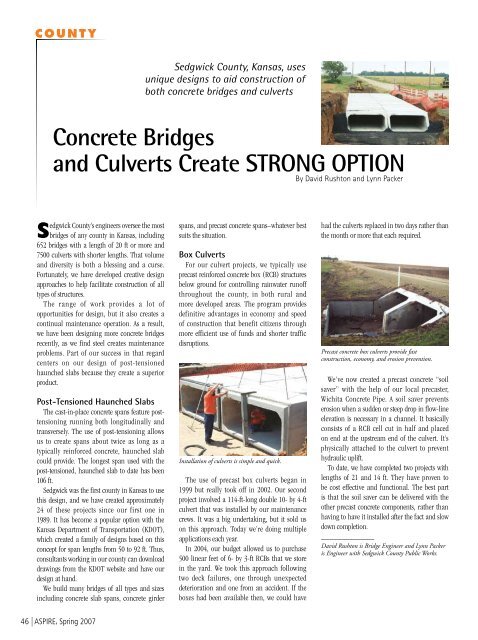ASPIRE Spring 07 - Aspire - The Concrete Bridge Magazine
ASPIRE Spring 07 - Aspire - The Concrete Bridge Magazine
ASPIRE Spring 07 - Aspire - The Concrete Bridge Magazine
You also want an ePaper? Increase the reach of your titles
YUMPU automatically turns print PDFs into web optimized ePapers that Google loves.
C O U N T Y<br />
Sedgwick County, Kansas, uses<br />
unique designs to aid construction of<br />
both concrete bridges and culverts<br />
<strong>Concrete</strong> <strong>Bridge</strong>s<br />
and Culverts Create Strong Option<br />
By David Rushton and Lynn Packer<br />
Sedgwick County’s engineers oversee the most<br />
bridges of any county in Kansas, including<br />
652 bridges with a length of 20 ft or more and<br />
7500 culverts with shorter lengths. That volume<br />
and diversity is both a blessing and a curse.<br />
Fortunately, we have developed creative design<br />
approaches to help facilitate construction of all<br />
types of structures.<br />
<strong>The</strong> range of work provides a lot of<br />
opportunities for design, but it also creates a<br />
continual maintenance operation. As a result,<br />
we have been designing more concrete bridges<br />
recently, as we find steel creates maintenance<br />
problems. Part of our success in that regard<br />
centers on our design of post-tensioned<br />
haunched slabs because they create a superior<br />
product.<br />
Post-Tensioned Haunched Slabs<br />
<strong>The</strong> cast-in-place concrete spans feature posttensioning<br />
running both longitudinally and<br />
transversely. <strong>The</strong> use of post-tensioning allows<br />
us to create spans about twice as long as a<br />
typically reinforced concrete, haunched slab<br />
could provide. <strong>The</strong> longest span used with the<br />
post-tensioned, haunched slab to date has been<br />
106 ft.<br />
Sedgwick was the first county in Kansas to use<br />
this design, and we have created approximately<br />
24 of these projects since our first one in<br />
1989. It has become a popular option with the<br />
Kansas Department of Transportation (KDOT),<br />
which created a family of designs based on this<br />
concept for span lengths from 50 to 92 ft. Thus,<br />
consultants working in our county can download<br />
drawings from the KDOT website and have our<br />
design at hand.<br />
We build many bridges of all types and sizes<br />
including concrete slab spans, concrete girder<br />
spans, and precast concrete spans–whatever best<br />
suits the situation.<br />
Box Culverts<br />
For our culvert projects, we typically use<br />
precast reinforced concrete box (RCB) structures<br />
below ground for controlling rainwater runoff<br />
throughout the county, in both rural and<br />
more developed areas. <strong>The</strong> program provides<br />
definitive advantages in economy and speed<br />
of construction that benefit citizens through<br />
more efficient use of funds and shorter traffic<br />
disruptions.<br />
Installation of culverts is simple and quick.<br />
<strong>The</strong> use of precast box culverts began in<br />
1999 but really took off in 2002. Our second<br />
project involved a 114-ft-long double 10- by 4-ft<br />
culvert that was installed by our maintenance<br />
crews. It was a big undertaking, but it sold us<br />
on this approach. Today we’re doing multiple<br />
applications each year.<br />
In 2004, our budget allowed us to purchase<br />
500 linear feet of 6- by 3-ft RCBs that we store<br />
in the yard. We took this approach following<br />
two deck failures, one through unexpected<br />
deterioration and one from an accident. If the<br />
boxes had been available then, we could have<br />
had the culverts replaced in two days rather than<br />
the month or more that each required.<br />
Precast concrete box culverts provide fast<br />
construction, economy, and erosion prevention.<br />
We’ve now created a precast concrete “soil<br />
saver” with the help of our local precaster,<br />
Wichita <strong>Concrete</strong> Pipe. A soil saver prevents<br />
erosion when a sudden or steep drop in flow-line<br />
elevation is necessary in a channel. It basically<br />
consists of a RCB cell cut in half and placed<br />
on end at the upstream end of the culvert. It’s<br />
physically attached to the culvert to prevent<br />
hydraulic uplift.<br />
To date, we have completed two projects with<br />
lengths of 21 and 14 ft. <strong>The</strong>y have proven to<br />
be cost effective and functional. <strong>The</strong> best part<br />
is that the soil saver can be delivered with the<br />
other precast concrete components, rather than<br />
having to have it installed after the fact and slow<br />
down completion.<br />
_____________<br />
David Rushton is <strong>Bridge</strong> Engineer and Lynn Packer<br />
is Engineer with Sedgwick County Public Works.<br />
46 | <strong>ASPIRE</strong>, <strong>Spring</strong> 20<strong>07</strong>

















